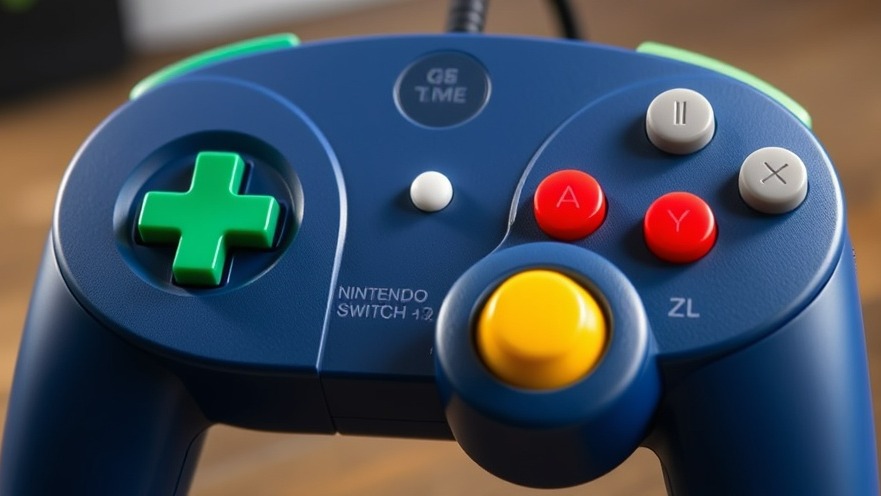
Unpacking the GameCube Controller for the Nintendo Switch 2: Is It Worth It?
For many gamers, especially those who grew up in the late '90s and early 2000s, the Nintendo GameCube holds a special place in their hearts. With classics like The Legend of Zelda: The Wind Waker and Super Smash Bros. Melee, the console was a beloved part of many childhoods. Consequently, the announcement of a new GameCube controller designed specifically for the Nintendo Switch 2 stirred up excitement among nostalgic fans. However, it’s essential to consider whether this controller truly encapsulates the nostalgic experience and if it stands up against modern gaming demands.
The Allure of Nostalgia in Gaming
Nostalgia has a powerful pull on consumers, especially in gaming, where memories of childhood experiences can influence purchasing decisions. The GameCube controller, revered for its ergonomic design and distinctive button layout, calls back to an era that many consider the golden age of gaming. However, with changes in gaming technology and design, this nostalgia can sometimes cloud practicality. While the controller may feel familiar with classic titles, its role in modern gaming requires careful consideration.
Compatibility: A Blessing or a Curse?
The GameCube controller for the Switch 2 is marketed primarily as a nostalgic accessory for retro games, but it carries limitations when it comes to compatibility with newer titles. Initially, it seemed that the controller's use was restricted solely to GameCube classics available through Nintendo Switch Online. This limitation drew concern from gamers afraid that their investment would only serve a narrow purpose.
Fortunately, Nintendo has since clarified that while the controller is optimized for GameCube games, it can be used with modern titles. However, the real worry is how well it will perform in these games. Nintendo’s warning of potential compatibility issues raises a red flag for gamers who expect seamless gameplay. The controller lacks several features that have become standard on modern controllers, which can significantly impact game performance.
Button Layout: A Barrier to Modern Play?
One of the critical factors to take into account when evaluating the GameCube controller is its button layout. While it boasts additional features like a tiny ZL button, many gamers note a glaring absence of critical buttons found on contemporary controllers. Features like L3 and R3 (the clickable joystick buttons) are nowhere to be found, which could limit gameplay in newer titles that rely on these functions. Furthermore, the controller’s non-traditional design—such as a large left joystick and a tiny C-stick—might take some getting used to, particularly for players accustomed to the intuitive ergonomics of today’s gaming devices.
Thinking Beyond Nostalgia: What Gamers Should Consider
It’s essential to weigh the benefits of nostalgia against practical gameplay. If you’re a digital nomad and gaming is a key activity for you, consider what your primary needs are. Will the sentimental experience enhance your current lifestyle, or will it hinder your ability to be productive and engaged with modern games?
Investing in a controller that only serves a narrow purpose could detract from your overall gaming experience, especially when juggling different responsibilities and interests that come with remote work or travel. Balancing your love for classic titles with the demands of modern gaming is paramount.
The Future of Gaming Controllers: Trends to Watch
This discussion leads to broader insights about the future of gaming peripherals. As technology advances, gaming experiences become increasingly immersive with a greater emphasis on user interface. Controllers are evolving to meet the needs of gamers who crave practicality over nostalgia. Understanding these trends can help you make informed purchasing decisions that cater to both your gaming needs and productivity goals.
Lessons Learned and Best Practices for Gamers on the Move
If you’re considering jumping on the GameCube controller hype or any new gaming hardware, here are some tips:
Research Compatibility: Always check compatibility notes for new accessories. If the promise of nostalgia leads to frustration during gameplay, it might be time to reconsider your purchase.
Prioritize Versatility: Invest in controllers that function well across a wide array of titles. Versatile devices enhance rather than restrict your gaming options.
Ease of Portability: Since many digital nomads travel frequently, opt for lightweight, compact gaming accessories that fit seamlessly into your mobile lifestyle.
 Add Row
Add Row  Add
Add 




Write A Comment